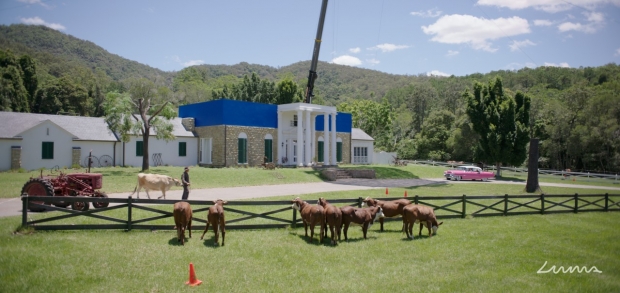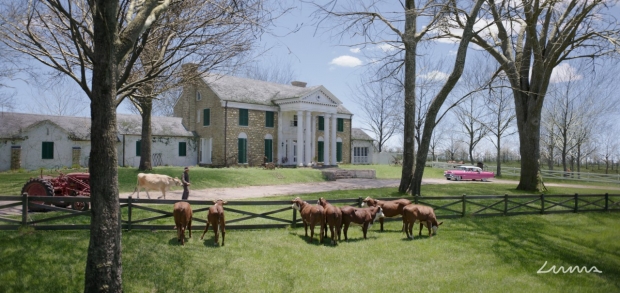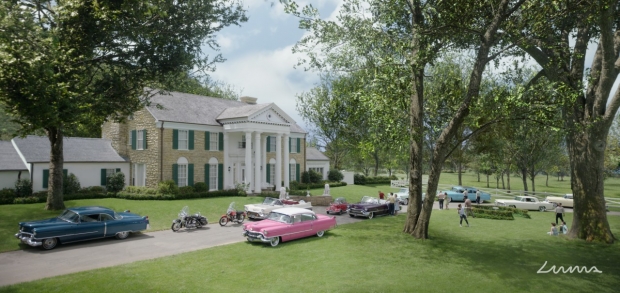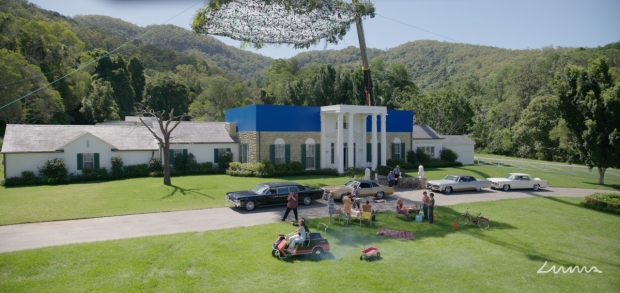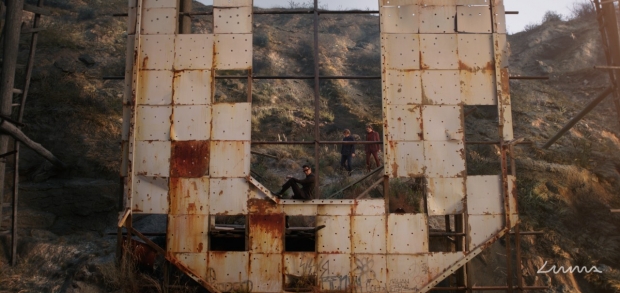The visual effects studio recreates the King of Rock & Roll’s famed home, showing its change over the course of 3 decades, along with shots of the iconic Hollywood sign, in Baz Luhrmann’s lush, colorful biopic.
Cultural icon Elvis Presley gets the biopic treatment by filmmaker Baz Luhrmann in the Warner Bros. Pictures’ drama, Elvis, which is told from the perspective of his controversial manager, Colonel Tom Parker. The art department at Luma Pictures contributed previsualization to the production, while the VFX artists delivered around 100 shots, focused on depicting the Graceland estate over of the course of three decades and different seasons, and recreating the famous Hollywood Sign situated in the Hollywood Hills of California.
Just as Presley was known for his showmanship, Luhrmann has gained a reputation for creating cinematic spectacles, and Elvis was no different. “If Baz or [Production VFX Supervisor] Tom Wood had an idea, Tom would email the references that they were looking at together,” states Compositing Supervisor Adam Hammond. “Tom would say, ‘This is what we’re looking at and this is how we want it to look.’ It wasn’t a case of us guessing or having to do two or three different versions and sending them to choose. That really helped especially when we’re deviating from realism.”
“We’re always balancing between delivering Baz’s vision, with things being vibrant and colorful, but also being embedded in reality,” he continues. “A lot of that was done in compositing and it was an interesting dynamic. The notes that we would get from a director like Baz is quite different than ones you get from other clients. Because of the subject matter and [this particular] director, there was a sense of fun and creativity even though we were creating reality.”
Depicting the famed Graceland property over several decades presented an interesting challenge: getting inside the director’s mind. “After receiving the brief, I thought the main thing was to fix and solve problems,” notes VFX Art Director Giorgio Iovino. “How do we visualize this because we have three decades and locations that really exist. Everybody knows Graceland, so we had to be accurate and consistent with reality but at the same time, try to explore it in different ways and approaches that matched Baz’s vision.” Everything was based on reality. “Our approach was to start from the photogrammetry and create some keyframes of a wider shot so we could have a vision about coverage. We wanted to avoid as many iterations as possible. Even breakdown of the environment, like what types of trees do we have? We built a blueprint for everyone to understand.” For Iovino, production methodology is always determined by how fast something needs to be turned around. “Generally, speaking I always like to start with a 3D base for accuracy and lighting purposes. In my previous life I was an environment matte painter and that’s why I have a photogrammetry style because it needs to be photorealistic. We need to breakdown the reality in order to make it work. 3D is the key to have a strong foundation. You can paint over if you need to be quick. Now with the new software tools it is quick to work in 3D.”
Seasons were used to help delineate between the different decades. “We first see Graceland when Elvis drives his pink Cadillac to his new house to show his mum and dad; that’s in winter in the early 1950s,” remarks Hammond. “Graceland is a farm and rundown, but it’s also winter so there are no leaves on the trees. That was a different look to what we see in the 1970s when it’s summer, the trees are a lot lusher and grown, Elvis has worked on the grounds, there are fences, and extra parts on the house. Even little things like the shutters on the windows. Playing into those shots, the time and the time of year helped to make them all look quite different.”
Everything apart from the first row of bricks and windows at the front of the house at Graceland was built in CG. “We had a DMP for the skies and did a lot of work in paint to fix a few things,” Hammond continues. “The set had to be embedded in and feel like lived in brick and concrete. There were a lot of small details. Things that you would struggle to notice that were painstakingly done by the paint department. Shadows of the things that we were adding like characters in the grass. There were also things that we had to remove such as bits of rig and tracks in the grasses. In a few shots you could see vehicles being driven over the grass.”
Photogrammetry was used for the digital matte paintings of the Hollywood environment backgrounds, which were created in CG, different than how the Graceland skies were made. “One of our supervisors in Los Angeles went to the Hollywood Hills and stood where that sequence takes place and took photos of everything,” remarks Hammond. “He took into account time of day and did a lot of texture reference for the CG that we had to do. It was huge panorama that we had to bring to life with DMP in compositing; that [photogrammetry] was valuable to give us a sense of the place. We had to augment it because we had photos of Los Angeles in 2021 as opposed to 1968, so there were changes to the skyline. The photos were brought to life in compositing because we wanted to see lights, movement, traffic and 2D elements of smoke to add depth.” A CG environment was created for the shot facing the Hollywood Hills when the camera tracks back to reveal the full Hollywood sign.
Something new for Luma Pictures was utilizing Unreal Engine in the layout process. “The art department fleshed out the key angles of how Graceland would look in the different decades and seasons,” explains Hammond. “To get the layout of all those trees and fences right and approved, one way we tackled that was using Unreal Engine. The layout team plotted out everything, we would do quick Playblasts in Unreal, and they were sent to Tom for signoff. Baz likes to have each frame perfect so there would be art direction of the tree placement based on angles. In order to address those notes quickly, we used Unreal. The layouts done per shot in Unreal were matched.”
Capturing reality itself was the biggest design challenge, such as placing trees in their real location, Iovino shares, “just to mimic and be consistent with such an iconic place, and to make it accurate and believable through the decades.”
Luckily there was no shortage of reference material. “It’s great working on a project like this because a lot of the things we see are [based on] actual events,” remarks Hammond. “There is a sequence where they are rehearsing for a show in the mid-1950s and Elvis is talking to Tom Parker. We did the environments seen out of those windows, but you can see pictures of Elvis in that room. I think what Baz was trying to create was a mood of how it felt at the time and using those photos of Elvis sitting on the steps of Graceland in the 1950s, 1960s, and 1970s, where you can see the changes in him and also in the house, just getting a feeling of that time, it was invaluable to have those references. But at the same time, working with Baz, he needs to amp everything up.”

